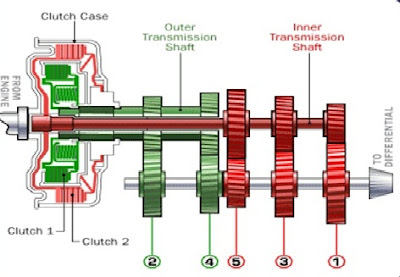Abstract
The report introduces and describes the technology of “Dual Clutch Transmission”, which is a relatively new technology. It has the advantage of both automatic and manual gears. It helps the driver to control the clutch without a clutch pedal, hence giving him a smoother driving. The technology has been used by various car manufactures and is gaining a large market.
Introduction
A
dual-clutch transmission offers the function of two manual gearboxes in one.
When a driver wants to change from one gear to another in a standard
stick-shift car, he first presses down the clutch pedal. This operates a single
clutch, which disconnects the engine from the gearbox and interrupts power flow
to the transmission. Then the driver uses the stick shift to select a new gear,
a process that involves moving a toothed collar from one gear wheel to another
gear wheel of a different size. Devices called synchronizers match the gears
before they are engaged to prevent grinding. Once the new gear is engaged, the
driver releases the clutch pedal, which re-connects the engine to the gearbox
and transmits power to the wheels.
If
the teeth, the so-called dog teeth, make contact with the gear, but the two
parts are spinning at different speeds, the teeth will fail to engage and a
loud grinding sound will be heard as they clatter together. For this reason, a
modern dog clutch in an automobile has a synchronizer mechanism or synchromesh,
which consists of a cone clutch and blocking ring. Before the teeth can engage,
the cone clutch engages first which brings the selector and gear to the same
speed using friction. Moreover, until synchronization occurs, the teeth are
prevented from making contact, because further motion of the selector is
prevented by a blocker (or baulk) ring. When synchronization occurs, friction
on the blocker ring is relieved and it twists slightly, bringing into alignment
certain grooves and notches that allow further passage of the selector which
brings the teeth together. Of course, the exact design of the synchronizer
varies from manufacturer to manufacturer.
Manual Clutch
In
all vehicles using a transmission (virtually all modern vehicles), a coupling
device is used to separate the engine and transmission when necessary. The
clutch accomplishes this in manual transmissions. Without it, the engine and
tires would at all times be inextricably linked, and any time the vehicle
stopped the engine would stall. Without the clutch, changing gears would be
very difficult, even with the vehicle moving already: deselecting a gear while
the transmission is under load requires considerable force, and selecting a
gear requires the revolution speed of the engine to be held at a very precise
value which depends on the vehicle speed and desired gear. In a car the clutch
is usually operated by a pedal; on a motorcycle, a lever on the left handlebar
serves the purpose.



